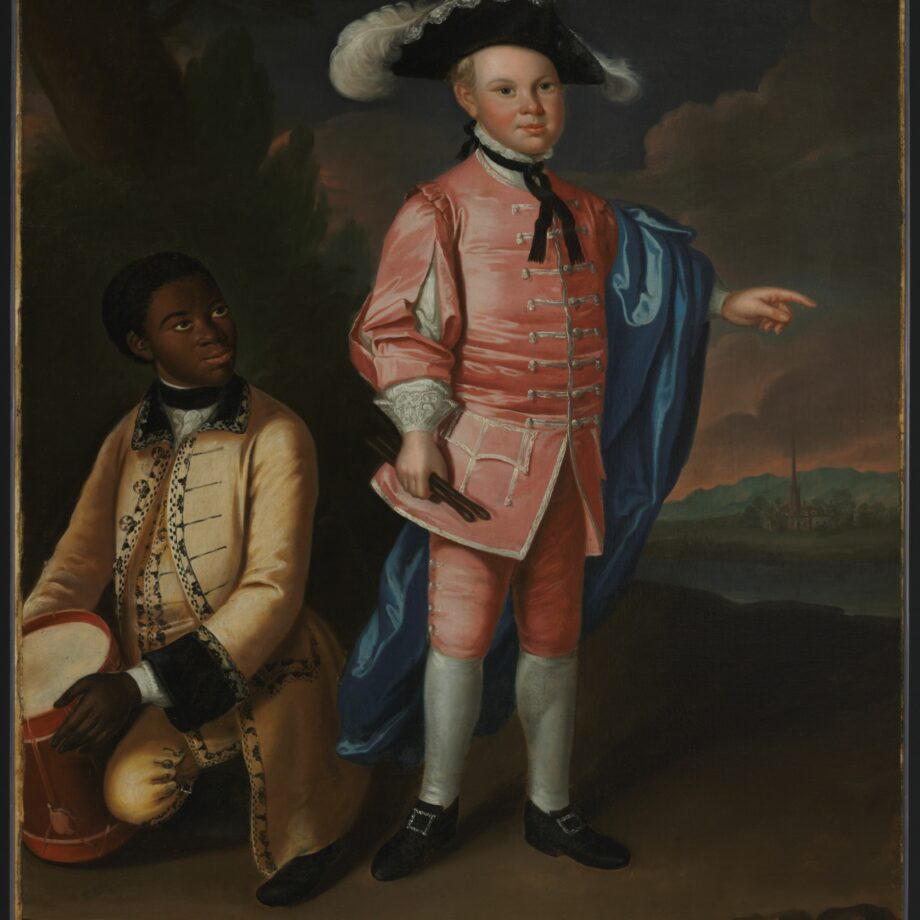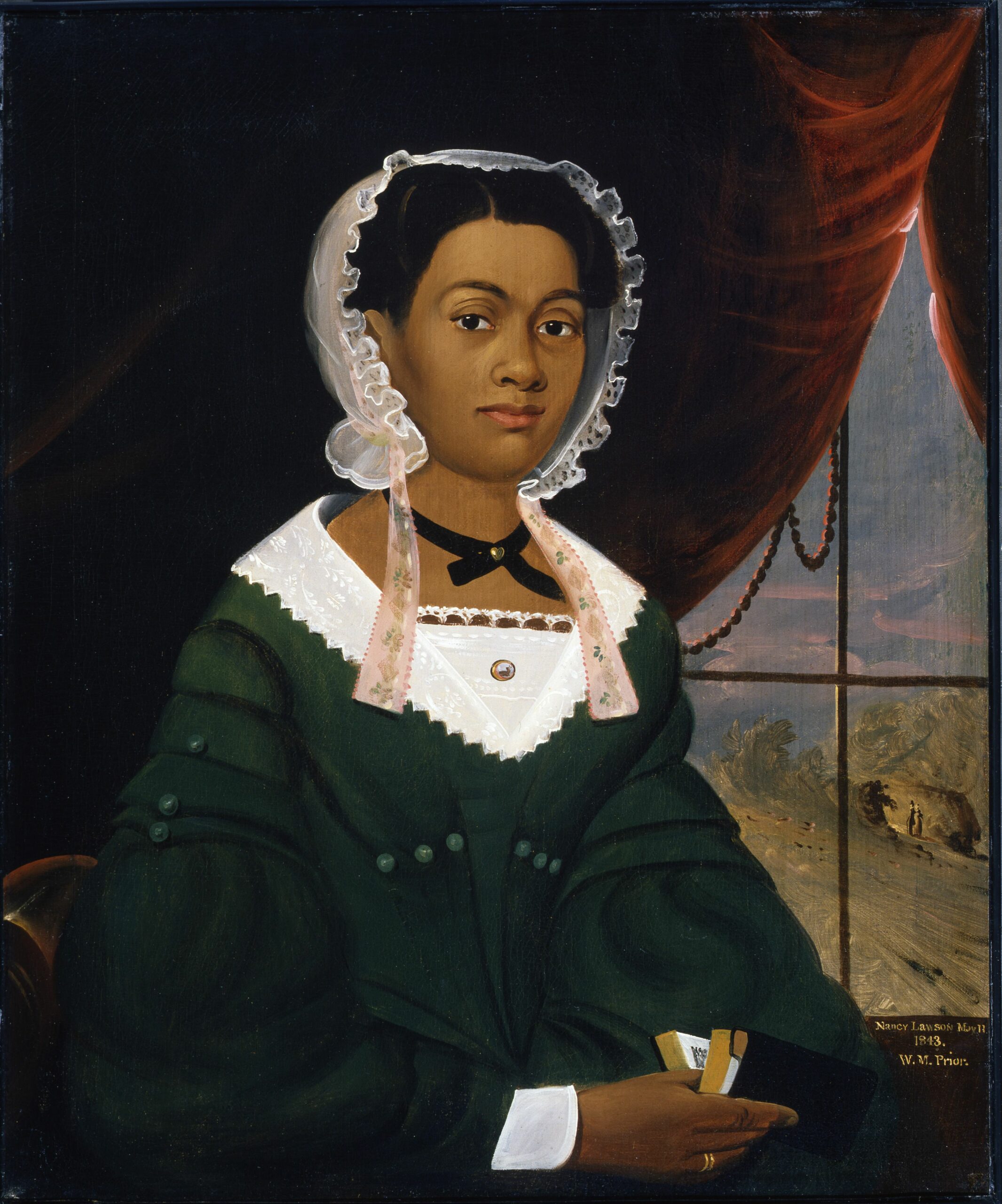
There is a commonly held misconception that for Black Americans, the North was a site of safety. Cities like Boston are often touted as the birthplace of abolition and Black freedom and existence, yet when looking at history books, there is a severe erasure of the lives, experiences, and contributions of Black Americans in the region. With the exhibition Unnamed Figures: Black Presence and Absence in the Early American North, currently on view at the American Folk Art Museum in New York City, curators Emilie Gevalt, Sadé Ayorinde, and RL Watson are challenging these absences and our understanding of Black history, which lest we forget, is American history.
The seeds for the exhibition were germinated when Gevalt was conducting coursework for her Ph.D. at the University of Delaware and came across Perry Hall, Home of Harry Dorsey Gough (1795-98), a landscape painting of a plantation outside of Baltimore, Maryland. The painting features the oft-used trope of a house portrait meant to worship and laud the wealth and eminence of a White family. The names of every White individual in the painting are known and have been documented, and even the name of the horse is known. As was often the case in these kinds of works, there was a Black housemaid in the frame who hadn’t been researched or identified. “There was an assumption that we couldn’t find out about her because of the gaps in the archive around Black lives during this time,” Gevalt says.
This foregrounds the focal point of the show, that just because Black Americans weren’t visually present in visual art or objects and have been left out of dominant narratives regarding the North does not mean that Black communities were absent
Following the threads that were revealed through this image, Gevalt teamed up with RL Watson, who was working on similar themes from a literary and cultural studies perspective, to begin organising and building the project. Curatorial fellow and assistant curator Sadé Ayorinde joined the team shortly after, and over the next few years, the three conducted research into portraits, landscapes, photographs, and objects from the late 1600s to the early 1800s that originated in the Northeast. The exhibition consists of 125 pieces.
Despite the time the show covers, Gevalt says there was a worry that they wouldn’t be able to find enough material, particularly because the faces, existence, and experiences that were historically portrayed in work from this period excluded Black people. Similarly, when Black people do show up in work, it’s done through the frame of the South and the trade of enslavement or depiction of the racial hierarchy in American society. Works like Charles Calvert and Once-Known Enslaved Attendant (c. 1761) show how Black Americans physically showed up in and were represented in art in the 18th century North, while landscapes like Perry Hall are representative of how they are physically absent from scenes, yet their presence via the setting of the painting is palpable.

Another example of this is a landscape painting depicting New Milford, Connecticut, in which no figures are present. In discussing the piece, Gevalt shares that while the landscape has historically been interpreted in terms of a White family’s property, it is also land that was stewarded and maintained by a Black family. This foregrounds the focal point of the show, that just because Black Americans weren’t visually present in visual art or objects and have been left out of dominant narratives regarding the North does not mean that Black communities were absent.
Perry Hall influenced Gevalt to look for Black Americans in places that could be viewed as unexpected. It also brought forth the question of why Black figures chose to be included––the argument can be made that it wasn’t a decision they had the privilege to make. Gevalt shares, “Black people lived in these regions, even though it’s a history that’s often swept aside.” Ayorinde adds that in organising the show, it was crucial to include instances in which Black Americans were represented on their own terms, “thinking about who is making and who is being represented.” This resulted in a section that focuses solely on Black makers. The works convey that enslavement wasn’t something that was a reality for all Black Americans, particularly in the North. By having a segment spotlighting freed Black Americans who were concerned with building communities, the exhibition challenges the governing history of Black life that is rooted in subjugation in the South.
By having a segment spotlighting freed Black Americans who were concerned with building communities, the exhibition challenges the governing history of Black life and a subjugated one that was only present in the South.
Working in tandem with the portrayal of Black makers are the portraits of Black sitters by Black painters. During our conversation, Ayorinde references Joshua Johnson, the premier Black painter, who was the first to make a living as a portraitist. Formerly enslaved, Johnson is considered the earliest documented professional Black American painter, though it was not until 1939 that his occupation or identity as such was confirmed. Since then, over eighty works have been credited to him.
Ayorinde notes how including Johnson in the show was critical to show an example of a Black person because so much of the show is White people representing Black people or Black people representing White people. She goes on to say that it provides an opportunity to think about the relationship between Johnson and the Black sitter. Additionally, it’s important to think about what it must have felt like for each of them to be occupying those societal positions. Traditionally, portraits were painted of and by White Americans. In engaging in these roles that had not been available to them before, they were subverting the systems and structures on which American society had been built.

They were also challenging the long-held idea of what a portrait is supposed to look like and who it is for. This is something that Gevalt, Watson, and Ayorinde also address in the exhibition. Some of the pieces in the portraiture section are of Black sitters painted by White portraitists as visual evidence that they could paint Black skin or, as Ayorinde states, a marketing ploy.
There are instances in the show in which works appear to be caricatures of Black people, but upon further research, the curators found they were tributes. Such is the case with Doll (Anthony or Darby Vassall) (c. 1850s) made by Mary E. Saunders. The doll was created in the tradition of eighteenth-century practices to commemorate Tony Vassall, though it has also been thought it could be the likeness of his son Darby. In the show’s accompanying publication, Gevalt writes that the doll is an example of an object that is meant to recognise Black figures but is complicated in its execution.
While Gevalt and Ayorinde share that the purpose of the show isn’t necessarily to confront an absence of representation in larger institutions, they wanted to work in that tradition by being intentional about all the pieces that are included in the show. A facet of the exhibition that works to do this is the interviews they conducted with descendants of some of the Black figures in the exhibited works. For the aforementioned landscape, the curators were able to get in touch with two women who are descendants of the Phillips family. In talking to the women, Gevalt shares that she learned that the Phillipses would frequent a local shop and are even recorded in account books. Despite the family’s long history in the town, they consistently encounter disbelief when they inform others that their families have been in the region for generations. As Gevalt says, “There is still this lingering doubt and disbelief around Black history in the North.”
There is still this lingering doubt and disbelief around Black history in the North.
Gevalt and Ayorinde emphasise that they don’t want the exhibition to conclude in a redemptive moment where a burgeoning Black middle class can self-style and represent themselves. In speaking to descendants to document their reactions to and thoughts on some of the works, as well as contemporary artists to provide their own interpretation, the curators bridge Black history and the current Black existence. Gevalt shares that one of the goals of the show was to say no to including contemporary interpretations of history and instead focus solely on telling stories through historical work. The descendant interviews aid in the exhibition’s mining of the archive and confronting the gaps that are present. Ayorinde states that they are able to talk about historical places and people and share stories that are only available through oral history.
While the exhibition and accompanying publication seek to highlight and uncover the histories and stories of Black Americans in the North, Gevalt acknowledges that there will always be questions they’re never able to answer. She relates Saidiya Hartman’s concept of ‘critical fabulation’ to her hopes for viewers engaging with the exhibition, “an invitation to imagine in spite of.” The exhibition serves as a reminder to examine art and objects in ways that are in contrast to how they have traditionally been analysed. As Gevalt says, “And to consider the importance of asking questions, even if they can’t be answered.”
Written by Karla Méndez






